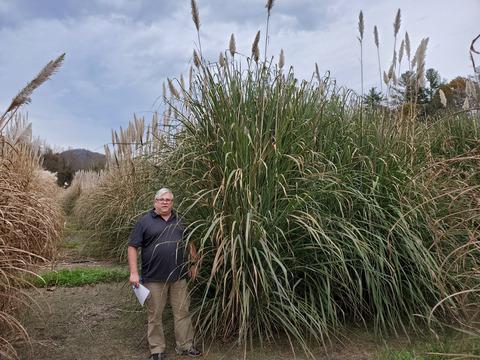当前位置:
X-MOL 学术
›
GCB Bioenergy
›
论文详情
Our official English website, www.x-mol.net, welcomes your feedback! (Note: you will need to create a separate account there.)
Biomass yields, cytogenetics, fertility, and compositional analyses of novel bioenergy grass hybrids (Tripidium spp.)
Global Change Biology Bioenergy ( IF 5.6 ) Pub Date : 2020-03-18 , DOI: 10.1111/gcbb.12676 Nathan A. Maren 1 , Darren H. Touchell 1 , Thomas G. Ranney 1 , Hamid Ashrafi 2 , Matthew B. Whitfield 3 , Mari Chinn 3
Global Change Biology Bioenergy ( IF 5.6 ) Pub Date : 2020-03-18 , DOI: 10.1111/gcbb.12676 Nathan A. Maren 1 , Darren H. Touchell 1 , Thomas G. Ranney 1 , Hamid Ashrafi 2 , Matthew B. Whitfield 3 , Mari Chinn 3
Affiliation

|
High biomass yields have been documented for Tripidium spp. (Erianthus spp., Saccharum spp.), but targeted breeding for bioenergy applications has been limited. Advanced, interspecific hybrids between Tripidium ravennae and T. arundinaceum were planted in replicated field plots in 2016. Comparative feedstock evaluations examined biomass yields, cytogenetics, plant fertility, and compositional analyses relative to Miscanthus × giganteus. Dry biomass yields varied as a function of year and accession and increased each year ranging from 3.4 to 10.6, 8.6 to 37.3, and 23.7 to 60.6 Mg/ha for Tripidium hybrids compared to 2.3, 16.2 and 27.9 Mg/ha for M. × giganteus in 2016, 2017, and 2018, respectively. Cytology and cytometry confirmed that Tripidium hybrids were tetraploid with 2n = 4x = 40 (2C genome size = 5.06 pg) and intermediate between T. ravennae with 2n = 2x = 20 (2C genome size = 2.55 pg) and T. arundinaceum with 2n = 6x = 60 (2C genome size = 7.61 pg). Plant fertility characteristics varied considerably with some accessions producing no viable seeds or fewer than that observed for M. × giganteus. Accessions varied significantly for flowering culm number and height and dates of peak anthesis ranging from 14 September to 2 October. Variations in yield and compositional analyses contributed to variations in theoretical ethanol yields ranging from 10,181 to 27,546 L/ha for Tripidium accessions compared to 13,095 L/ha for M. × giganteus. Relative feed value (RFV) indices for winter‐harvested Tripidium accessions varied from 52.8 to 60.0 compared to M. × giganteus with 45.4. RFV for summer‐harvested Tripidium accessions varied from 71.6 to 80.5 compared to M. × giganteus with 61.0. These initial findings for Tripidium hybrids, including high biomass yields, cold hardiness, and desirable traits for multiple markets (e.g., forage, bioenergy, bioproducts), are promising and warrant further development of Tripidium as a temperate bioenergy feedstock.
中文翻译:

新型生物能源草杂种(Tripidium spp。)的生物量产量,细胞遗传学,育性和组成分析
Tripidium spp的生物量产量很高。(Erianthus spp。,Saccharum spp。),但是用于生物能源应用的目标育种受到限制。先进,间种间杂种Tripidium ravennae和T.茅种植在复制田间小区在2016年比较原料评价检查相对于生物质的产率,细胞遗传学,植物生育力,和组成分析芒草 × 巨。三id的干生物量产量随年份和入藏量而变化,并且每年以3.4 Mg / ha的范围增加,从3.4到10.6、8.6到37.3和23.7到60.6 Mg / ha杂交种,2016年,2017年和2018年的M. × giganteus分别为2.3、16.2和27.9 Mg / ha 。细胞学和流式细胞术证实Tripidium杂交种四倍体用2 Ñ = 4 X = 40(2C基因组的大小= 5.06微克)和中间体之间T. ravennae 2 Ñ = 2 X = 20(2C基因组的大小= 2.55微克)和T. 2 n = 6 x = 60(2C基因组大小= 7.61 pg)的arundinaceum。植物的育性特征差异很大,有些种质没有产生存活的种子,也没有产生比M. × giganteus少的种子。。从9月14日至10月2日的开花花序数量,高度和最高花期的日期,种质差异很大。产量和成分分析的差异导致三倍体品种的理论乙醇产量在10,181至27,546 L / ha的变化,而M. × giganteus则为13,095 L / ha 。冬季收获的三叉戟种质的相对饲料价值(RFV)指数从52.8到60.0,而M. × giganteus则为45.4。与M. × giganteus相比,夏季收获的三叉戟种质的RFV在71.6至80.5之间变化与61.0。Tripidium杂种的这些初步发现,包括高生物量产量,耐寒性和多个市场的理想特性(例如,牧草,生物能源,生物制品),是有希望的,并有待进一步开发Tripidium作为温带生物能源原料。
更新日期:2020-03-18
中文翻译:

新型生物能源草杂种(Tripidium spp。)的生物量产量,细胞遗传学,育性和组成分析
Tripidium spp的生物量产量很高。(Erianthus spp。,Saccharum spp。),但是用于生物能源应用的目标育种受到限制。先进,间种间杂种Tripidium ravennae和T.茅种植在复制田间小区在2016年比较原料评价检查相对于生物质的产率,细胞遗传学,植物生育力,和组成分析芒草 × 巨。三id的干生物量产量随年份和入藏量而变化,并且每年以3.4 Mg / ha的范围增加,从3.4到10.6、8.6到37.3和23.7到60.6 Mg / ha杂交种,2016年,2017年和2018年的M. × giganteus分别为2.3、16.2和27.9 Mg / ha 。细胞学和流式细胞术证实Tripidium杂交种四倍体用2 Ñ = 4 X = 40(2C基因组的大小= 5.06微克)和中间体之间T. ravennae 2 Ñ = 2 X = 20(2C基因组的大小= 2.55微克)和T. 2 n = 6 x = 60(2C基因组大小= 7.61 pg)的arundinaceum。植物的育性特征差异很大,有些种质没有产生存活的种子,也没有产生比M. × giganteus少的种子。。从9月14日至10月2日的开花花序数量,高度和最高花期的日期,种质差异很大。产量和成分分析的差异导致三倍体品种的理论乙醇产量在10,181至27,546 L / ha的变化,而M. × giganteus则为13,095 L / ha 。冬季收获的三叉戟种质的相对饲料价值(RFV)指数从52.8到60.0,而M. × giganteus则为45.4。与M. × giganteus相比,夏季收获的三叉戟种质的RFV在71.6至80.5之间变化与61.0。Tripidium杂种的这些初步发现,包括高生物量产量,耐寒性和多个市场的理想特性(例如,牧草,生物能源,生物制品),是有希望的,并有待进一步开发Tripidium作为温带生物能源原料。



























 京公网安备 11010802027423号
京公网安备 11010802027423号